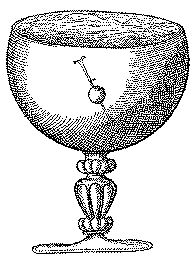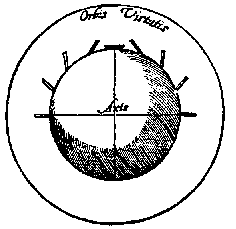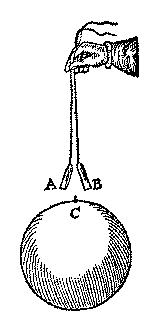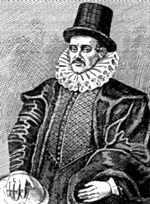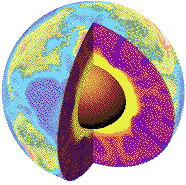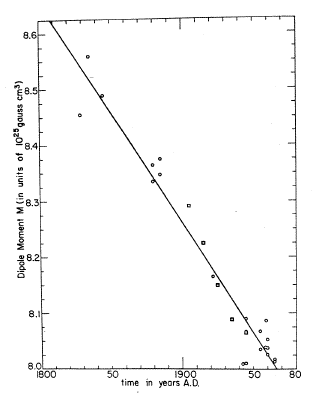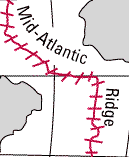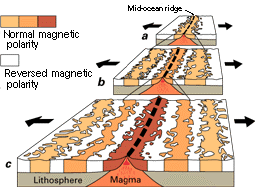Items covered:
- What is "Magnetic Flux" and what are "Flux Lines"?
- Is the surface of the Earth expanding?
- Will a Compass work inside a Car?
- Pole shifts? What Pole Shifts?
- What was it that Ned Benton did?
- Reversals of the Earth's field (4 queries)
- Can Magnetism propel Spaceships?
- Reversal of the Sun's Magnetic Poles
- Measuring Earth's magnetic field
- The strength of the Earth's mgnetic field
- Magnetic Shielding
- Building an electromagnet
- How do Magnetic Reversals affect Animal Migrations?
- Which is the "True" North Magnetic Pole?
- Magnetic intensity at Singapore
If you have a relevant question of your own, you can send it to
u5dps@lepvax.gsfc.nasa.gov.
Before you do, though, please read the
instructions
Question #1
What is "Magnetic Flux" and what are "Flux Lines"?
I am retired from IBM. I love to read about space and astrophysics. When
reading about the magnetic force, flux lines are mentioned. My question
is: what are these flux lines made of. Does the magnetic force field have
an exchange particle? Or are magnetic flux lines absent of any particles?
This area never seems to be covered in any articles that I have read.
REPLY
Dear Paul
"Flux lines" is another name for magnetic field lines, originally
named "magnetic lines of force" by Michael Faraday, who introduced them.
What is "flux"? You may be aware that the mathematical description of
magnetic fields is very similar to that of a fluid like water, which
cannot be compressed. Where magnetic fields have "field lines", flowing water
has "streamlines" (we talk about the interior flow, ignore the surface)
and both field lines and flux lines are closed loops.
In describing "fluid motion" the "flux" through an area--or the one carried
by a bundle of streamlines--is the amount of water crossing it per second,
or crossing each second any cross section of the bundle. Magnetic flux
of a bundle of lines is similarly the cross sectional area of a bundle of
field lines, TIMES the average field intensity on it. Mathematically,
both are similar. Flux is important in designing transformers, etc.
Some engineers call the flux through a cross section "the number of magnetic
field lines" through it, but it's the same thing. You can see from that how
the word "flux line" arose.
Back to the main list
Question #2
Is the surface of the Earth expanding?
I am a university student taking business, I often have a few
interests during a week of abstract ideas. I am currently in two geology
courses as electives, and that is how I stumbled across your homepage,
while looking for information on the movement/change reversal of our
magnetic poles.
Part of our geology course was obviously the
expanding and contracting of the continental plates. On average, using
your knowledge, does the surface of the earth increase or decrease
within terms of expanding from plate movement, and if so (I'm going to
try to phrase this intelligently) does the atmosphere end up spreading
itself thinner and therefore covering the new surface of the earth?
REPLY
Dear David
It is difficult to reconstruct what went on millions of years ago.
However, one can be pretty sure that AT THE PRESENT TIME (1) The crustal
plates of the Earth ARE moving and (2) The Earth IS NOT expanding or
shrinking. Point (1) was confirmed by accurate distance measurements based on signals from radio stars, the VLBI experiment (Very Large Baseline Interferometer),
and more recently by the satellite-based Global Positioning System (GPS)
which (as you might know) is capable of greater accuracy than the public
is allowed to use. Point (2) is derived by comparing the observed rotation
period of the Earth, measured by telescopes, with very accurate clocks.
Even a tiny expansion or contraction would slow down or speed up the Earth's
rotation. The Earth's rotation is observed to slow down, but from all I
know this is explained by loss rotational energy to ocean tides, which
transfer angular momentum to the Moon.
Back to the main list
Question #3
Will a compass work inside a car?
Dear Dr. Stern,
I was recently told that a compass will not work inside of a metal
building. Is that true? Doesn't the field still propagate through the
concrete floor, even though surrounded by a metal roof and walls? Also,
I'm told that compasses that are available in automobiles must be
specifically calibrated to compensate for their metal enclosure.
REPLY
Dear Gordon
Here is what I can write off the top of my head: I will ask around
and if any of what follows is not correct, you will hear from me again.
It is true that iron channels magnetic fields. Magnetic field lines of
the Earth crowd into any iron oriented north-south, and since they are
denser inside the iron, in the surrounding space they are more spread
out, that is, the magnetic intensity there is weaker. Iron walls (if
sufficiently thick) can therefore shield out magnetic fields, as
described in http://www.phy6.org/earthmag/magmeter.htm ,
"About Electronic Magnetometers and about Smoking" (last section there).
However, I don't think a reinforced concrete building has enough iron
to make much of a difference. Cars may be somewhat different, and their
structural iron may be the reason why a car compass is usually mounted
high on the windshield, next to the rear-view mirror. The accuracy
demanded of car compasses is in any case so small--they only need enough
to tell a right road from a wrong one-- that small deviations may be
tolerated.
It is not so with ships and airplanes, whose navigation demands
precision. Thanks to today's global positioning system, and before that, to
gyrocompasses and radio beacons, this may be a moot point, but at least
up to WW II the magnetic correction to a magnetic compass on a ship was
quite important. The compass was placed on a pedestal called the
binnacle, under an ellipsoidal cover of brass (brass has no magnetic
influence) with spheres and bars of soft iron attached on the side,
their positions calibrated to cancel the ship's effect. The binnacle
stood in the open, since the enclosed bridge was surrounded by iron, but
an electric repeater provided a helmsman inside the bridge with the
compass heading.
I hope this tells you all you wanted to know.
Back to the main list
Question #4
Pole Shifts? What Pole Shifts?
Given current knowledge on the subject of a pole shifts, where
would the exact pivot point be and nearest large city in such an event.
How does Antarctic ice buildup effect this process? What is the
likelihood of such an event in our lifetime? Best guess?
REPLY
Dear Gary
I am not sure what you mean.
The poles of the Earth wobble in a small circle, a fraction of a mile--
due, I believe, to the attraction of the Moon on the equatorial bulge
(I may be wrong here, have not checked). However, that is apparently not
what you have in mind.
Before 1965, there existed a theory of "polar wandering" by which the
poles wandered all over the Earth's surface--or to be more accurate, the
crust of the Earth slid around the interior which, containing most
of the angular momentum, rotated more or less without change. That
theory was motivated by the magnetic record in lavas: when lava from
a volcano hardens, it records the direction of the Earth's magnetism
at that time. Geologists, examining ancient lavas, found that at times
north and south were interchanged, and for India, it was 90 degrees from
either direction.
From the magnetization of the sea floor we now know better (see
http://www.phy6.org/earthmag/reversal.htm). Those observations
led to "plate tectonics," suggesting that pieces of the crust indeed
move slowly, but not at all in unison--different plates move differently.
India has moved from south of the equator to where it is now (and the
collision continues, raising the Himalaya mountains). We also understand
that in the past the Earth's magnetic poles exchanged polarity now and
then, typically half a million years apart (on the Sun this happens
every 11 years or so).
The poles thus don's shift. Land masses may shift--one half of San
Francisco is sliding past the other half, for instance, with the San
Andreas fault in between. But the rate is only about one inch per year.
Dr. David P. Stern
Back to the main list
Question #5
What was it that Ned Benton did?
Dear Dr. Stern,
I was reading a section 'Gauss and Global
Magnetic Field ' from http://istp.gsfc.nasa.gov/earthmag/gauss.htm
and encountered your reference late Ned Benton. Excuse my ignorance -
who was Ned Benton. Could you give me reference of his work saying that
the Earth's magnetic field may not reach zero but at some stage the
polarity of the geomagnetic field may flip as observed from
paleomagnetic studies.
REPLY
Dear Nalin
The article by Benton et al appeared in Geophysical Research letters--I
think in the mid 1980s. Ned (Edward) Benton died not long afterwards,
from cancer, still quite young. If I find the reference I will send it
to you, but meanwhile, let me explain what Benton and his two co-workers
did.
The Earth's field slowly changes, all the time. As I explained in the
section on Gauss, the field can be resolved into terms that depend on distance R like 1
over the 3rd, 4th, 5th etc. power of R: the dipole goes like 1/R3
and increasing powers are associated with parts of increasing
complexity.
The complex parts--e.g. those that go like 1/R7 are very small at
the surface of the Earth, but clearly they grow much faster than the
dipole as you move inwards: at a distance of half the radius of the
Earth, for instance, the dipole field is 8 times stronger, but the
1/R7
Actually, of course, you can only do so up to the boundary of the
core: after that you are in a region of electric currents, and the
description introduced by Gauss must be replaced with a different one,
which does not grow so fast.
The Earth's dipole field is declining at a rate that suggests it will
cross zero before the year 4000. Benton however knew from theory, that
(under appropriate restrictions) the core field cannot change its energy
that fast. He therefore proposed that what is actually happening is a
transfer of energy from the dipole to more complicated parts of the
field. Others have voiced the idea, but Benton and his colleagues found
a way to test it. You can calculate the energy of the field outside the
core, and also (from the observed change rates of field parts with
various complexity) the rate at which this energy changes. The unknown
quantity here is the radius of the core, at which the calculation stops.
Benton assumed that the total energy did not change, and from that
calculated the radius of the core. He got a value very close to the one
obtained in earthquake studies.
That suggests that dipole reversals are not associated with general
decay of the field--it is just its dipole part that goes through zero,
and other parts actually grow stronger. During reversals you will see a
weaker field (the complex parts decrease faster with distance from the
core) and perhaps 4 or more magnetic poles.
You can now see why I was reluctant to go into details! They can be much
more complicated. But that is what physics usually involves.
Back to the main list
Question #6
Four questions about Magnetic Reversals ***
Question #6-A
I need to know as much as possible about the reversal of the magnetic
field:
- how it was noticed
- who discovered the reversal
- how long ago did it reverse
- how many times did it reverse
- more information about the radiation from the sun if the magnetic
field reverses.
REPLY
ABOUT GEOMAGNETIC REVERSALS: This is a huge subject and I cannot do quick justice to it: look up in the index volume of the Britannica under: Geomagnetism, Plate tectonics, Reversals of the Earth's magnetic field.
HOW IT WAS NOTICED: When lava pours from a volcano, it solidifies to a black rock called basalt. Basalt is slightly magnetic, and it takes on the direction
of the surrounding magnetic field at the time it solidifies. Scientists
examined lavas for their magnetism early in this century (I believe) to see
how consistent the direction of ancient magnetic fields was with the direction
we observe now (would compasses point in the same direction?). The directions
generally agreed, but there existed reversals of directions which suggested
that there were times in the past when the poles were roughly interchanged.
No one knew what to make of it. Some suggested "polar wandering", that
the whole surface of the Earth slid around the interior like a loose shell.
WHO DISCOVERED: I don't remember. Check a book by Allan Cox, a collection
of historic articles.
But a big change happened in 1963. People noted that while rocks on Earth
were magnetized in a disordered way, the sea bottom was magnetized in long
strips. Larry Morley (whose article was regarded so speculative that journals
would not publish it) and then Matthews and Vine (who managed to publish)
suggested that molten rock was spreading out like a conveyer belt from volcanic
cracks in the middle of the ocean floor, e.g. the one in the middle of the
Atlantic (Azores islands sit on it). Or rather like 2 belts, one moving towards
Europe, one towards America, carrying on them the continental plates, so that
Europe and America gradually drift apart. As each belt comes out of the crack,
its lava solidifies to basalt, causing it to become magnetized, and when the field
reverses, its magnetization reverses too. So the bottom of the ocean records
the field like the tape of a tape recorder, containing perhaps 50 million years
of record.
HOW LONG AGO: about 700,000 years, according to the "tape recorder"
HOW MANY TIMES: Many, about half a million years apart on the average.
RADIATION FROM THE SUN: Sunlight of course is undisturbed. High-energy
protons from the Sun are usually diverted by the magnetic field. During
the reversal the field probably does not disappear, but becomes complex
and weaker, and protons can more easily reach the atmosphere, as they do now
within 1000 miles or so of the magnetic pole. On the ground it makes
no difference because the thick atmosphere shields us very well, and none
of the protons penetrates far into it.
David P. Stern
Question #6-B
Reversal of magnetosphere
We have been studying the magnetosphere and the Van Allen radiation
belts in a high school physical science class. It has been brought to
our attention that the magnetic poles of the earth reverse on an average
of about every 500,000 years. The last change was about 700,000 years
ago, so it would appear that we are long overdue.
What are the implications of this? How significant would the
fluctuation of the magnetic field during such a change be on our
protection from solar wind?
Ricky
REPLY
Dear Ricky
Only yesterday a similar question was submitted, so as a shortcut a copy of it [next item below] and its answer are attached below.
Some people worry that during magnetic reversals the Earth
would receive a higher dosage of high-energy ions and electrons
("radiation" in common terms), which might affect us and any living
creatures on Earth. This is not so. Even today, the magnetic shield
is not effective near the magnetic poles, yet the radiation received
there on the ground is only slightly higher than anywhere else. The
reason is that our main shield against such particles is not the magnetic field of the Earth but the atmosphere, equivalent to some
10 feet of concrete.
In any case, during reversal the magnetic field does not go away,
it only gets weaker and develops several more magnetic poles,
at unpredictable locations.
Question #6-C
Could you tell me when the earth's magnetic poles will change, and what
will happen when it does? Will it happen fast (seconds) or slowly?
Thank you!
Sarah
REPLY
Dear Sarah
No one knows when the next field reversal will occur: in the past,
they have occurred on the average about once in 700,000 years. The change, whenever it occurs, will be gradual and the field will not drop to zero in between--doing so would mean that the magnetic energy of the Earth was somehow converted or dissipated, and all processes we know for this tend to run on scales of thousands of year, if not more.
Right now the main (dipole) field is getting weaker at a rate of
about 7% per century, and if you draw a straight line through the points
you find it reversing between 1000 and 2000 years from now. It might happen,
although the trend may well change. The energy of the field, however, has
hardly changed. What seems to have happened is that the more complicated
parts of the field (equivalent to several magnets in different directions)
have got stronger while the main two-pole ("dipole") field lost strength.
The complex field is somewhat weaker (it drops off faster with distance
from the source, which is the core of the Earth), but we should not
expect the field to be ever greatly weakened.
The polar field of the Sun seems to reverse every 11 years or so,
taking about a year or more. But the Sun's magnetism is different,
it has foci right on the surface, in sunspots.
Hope this answers it.
David Stern
Question #6-D
Earth's magnetic field weakening--leading to a pole shift?
I am just a tax paying citizen, interested in astronomy all of my life.
I am very interested in the physics of our Earth which I believe is
related to astronomy as it is our home and a part of this solar system.
My question is: Is the Earth"s magnetic field weakening, heading to
zero point? With this, is the base pulse frequency of the Earth
speeding up causing the magnetic fields to fluctuate so that it
interferes with the pilots navigational equipment, so that
the navigational charts have to be redrawn periodically and the
air strips renumbered? Are the magnetic poles fluctuating? My
experience is that they are. I have a quality, liquid filled compass
secured to my desk. It has been very still now for the past month but
the six weeks or so prior to that, there were consistent fluctuations
in its direction, up to as much as 2 1/2 degrees, always to the west.
My understanding is: I have seen photographs of the sun taken from
satellites, showing the sun going through major activity. Repolarizing
itself? Causing the earth to repolarize itself? Going through a natural
cycle as it has many times in the past with pole shifts? On a scale
from 1 to 10, with 1 being the weakest and 10 the strongest, 2,000 years ago
it was a 10, today it is a 1. Is it heading for a zero point when a pole shift
will occur? The closer it gets to the zero point, the more fluctuations
will occur?
Are the change in the magnetic frequencies causing at times a confusion
in migratory animals? Causing cells to mutate, changing the DNA pattern
within the cell? Causing certain strains of bacteria such as staph
infections to become resistant to our antibiotics and causing new
viruses to appear that we have never seen before, being able to survive in
a new magnetic frequency?
I believe these are very fascinating times in which we live. The science
of all of this intrigues me to no end. I have some taped interviews
of scientists and geologists relating to this subject and I read all that
I can get my hands on, on the subject also. Your straightforward comments
and answers will be most welcomed to help me to understand more, what
is taking place. Thank you so very much.
Michael
REPLY
Dear Michael
Is the Earth's field getting weaker? Yes and no. That field is often
viewed as being a two-pole ("dipole") structure similar to that of a
small bar-magnet at the center of the Earth, inclined by about 11 degrees
to the rotation axis of the Earth, so that the magnetic poles are not the
same as the geographic ones. But the actual situation is more complicated,
and magnetic charts note the fact by mapping deviations between magnetic
north and the direction to the magnetic pole, which fit no simple pattern.
Why? Because the magnetic field is actually more complicated, and it
contains additional fields, of more complex nature. All this originates
in the Earth's core, about half the radius of the Earth. If we could go
to the surface of the core, all the complicated parts would be much
bigger. But they weaken more rapidly with distance, so at the surface
of the Earth they are already quite weak, while the "dipole" part
stands out more (in addition of actually BEING the biggest chunk of the
field).
Are you still with me?
The magnetic field of the Earth changes all the time, and yes, magnetic
charts have to be redrawn from time to time (this was first found in
1641, by an Englishman named Gellibrand). And yes, in the century
and a half since the first careful mapping of the Earth's field, the
dipole has become weaker by about 8% (the rate may have speeded up in
1970). If you draw a straight line through the points, you will find
that perhaps 1200 years from now, the line goes through zero.
Extending straight lines too far beyond the present, however, is risky
business, as noted by no less a scientific authority than Mark Twain.
In "Life on the Mississippi" Twain noted that the Mississippi river was
getting progressively shorter (mainly by floods--and by people--creating
shortcuts through bends in the river) and he wrote:
"Now, if I wanted to be one of those scientific people, and "let on"
to prove what had occurred in the remote past by what had occurred in
a given time in the recent past, or what will occur in the far future
by what has occurred in late years, what an opportunity is here! ...
Please observe:
In the space of one hundred and seventy six years the lower Mississippi
has shortened itself two hundred and forty-two miles. That is an average
over a mile and a third per year. Therefore, any calm person, who is not
blind or idiotic, can see that in the lower Oolitic Silurian Period,
just a million years ago next November, the lower Mississippi was upward
of one million three hundred thousand miles long, and stuck out over the
Gulf of Mexico like a fishing rod. And by the same token any person can
see that seven hundred and forty years from now the lower Mississippi
will be only a mile and three quarters long, and Cairo and New Orleans
will have joined their streets together, and will be plodding comfortably
along under a single mayor... There is something fascinating about science.
One gets such wholesale returns of conjecture out of such a trifling
investment in fact."
It is not impossible that the magnetic field will go through zero
1200 years from now, but (judging by the past record of reversals) not likely.
In any case, the field is not going away: when one uses observations on the
surface to reconstruct fields at the core, one finds that while the dipole
field is getting weaker, the complicated parts are getting stronger, and
the total magnetic energy does not change, within our observational
accuracy. That's why I wrote "yes and no."
I don't know about migrating animals (they may have magnetic organs,
sort of built-in compasses), but there seem to exist no magnetic effects
on DNA, resistance to antibiotics and so on; those changes seem more
related to chemistry.
Finally, be cautious with compass readings in your house. Houses do
contain electric currents and machinery, and these may affect the readings
of a magnetic compass. On NASA's satellites the magnetic sensor usually
sits at the end of a long boom, to keep it away from interfering electric
currents in the satellite's circuits.
Keep up your interest in science!
David
Back to the main list
Question #7
Can Magnetism propel Spaceships? ***
Dear Mr. Stern:
I am an Industrial Technology teacher at a middle school
and one of my students is dreaming of a space propulsion system based on
magnetic repulsion of the earth's magnetic field. Could you possibly
squeeze in a moment for us and provide some information on the strength of this field and how it has been measured and maybe a relative comparison? Tyson, my student, is really excited about the Internet and will be enthralled to have an answer from a NASA scientist. Perhaps you could steer him to other references as I certainly will explain to him how busy a schedule you must have. Thank you.
REPLY
I am afraid it won't work. First of all, the magnetic field is very
weak. Compared to fields in electric machinery, where appreciable forces are
exerted, it is a few thousand times weaker.
But there is a more fundamental reason. Magnetic poles always come in pairs, equal and opposite: if a field attracts an N pole, it repels the attached
S pole. Similarly, if we generate the field by a current in a loop of wire
--say, shaped like a rectangle--for each side in which the current flows
in one direction, there exists a side where it flows in the opposite direction,
and the magnetic field exerts opposite forces of equal strength on the two
sides.
From the preceding one would guess that magnetic forces always cancel,
and no net force is exerted. So how come magnets are attracted to each
other, or pins to a magnet (same thing, really, since each pin in the magnetic
field turns into a small magnet)?
The answer is that the forces on the N and S poles (or on the opposing
currents) are not exactly equal, if one pole, or one wire, is closer to the
source of the field than the other. This can be put into a mathematical
formulation and the bottom line is that a suitably oriented magnet may be
attracted by a magnetic field, moving towards the greatest strength of that
field. But the force is proportional to the rate at which the field changes with distance, which in the case of the Earth, is very small.
The idea of magnetism as anti-gravity has come up before. Your student may
look up "Gulliver's Travels" by Swift, where in the third voyage, in a spoof
on science and learned societies, Gulliver arrives at an island floating
in the air, held there by the repulsion of a large magnet. Swift even
gives an explanation, except it's all gibberish gobbledygook, as befits a book
of satire
Back to the main list
Question #8
Reversal of the Sun's Magnetic Poles ***
Dear Mr. Stern:
I have a question about the sun that I was hoping you might be able to
answer for me. A friend of mine recently returned from a new-age conference where it was presented that the magnetic poles of the sun were about to reverse, and cause a number of changes.
The idea of the sun having magnetic poles seemed counter to what I remember
learning about the sun, and your web page seems to dispel the idea that the
sun has actual poles. My guess is that the presenter was taking a dose of
creative license with the 11 year cycle of sunspot activity.
Is it true then, that:
1.) There are no magnetic poles on the sun.
2.) Is the change in sunspots related at all to a reverse of polarity of
magnetic fields?
Thank you.
If you can provide reference to a college-level text as a reference, it would
be appreciated.
REPLY
Actually, your friend was right: the Sun does have polar
fields, and they do seem to reverse their polarity each sunspot cycle.
The Sun's most concentrated magnetic fields are of course in sunspots, but
people have long suspected there might also exist polar fields, because during
a total eclipse of the Sun one often sees streamers coming out from the polar
regions, looking very much like the pattern of iron filings near the poles
of a magnet.
But there was no good way of measuring such diffuse magnetic fields: the
field of sunspots affects the light emitted from them ("Zeeman splitting")
but the effect elsewhere is very weak. Then in the 1950s (if memory serves
me) the Babcocks pushed the technique to its limits and found the polar field.
This revealed the reversal of the polar magnetic field and suggested this field
was somehow coupled to that of sunspots (which also reverse each cycle--they
come in pairs, and the leading spot, in the direction of the Sun's rotation,
has north or south polarity, in alternate cycles), a sort of a cumulative
effect of the distant field of many spots. Theories exist by Horace
Babcock and Robert Leighton, though they are somewhat qualitative.
The fact the magnetic field lines at the poles stick straight out means they
do not hinder the escape of the solar wind in any way, and indeed the Ulysses
spacecraft which recently passed above the Sun's poles confirmed (as was
predicted) that the solar wind there is faster. There seems to exist no great
effect of the reversal on Earth, though one might expect a bit more magnetic
storminess when the polarity is opposite to that of the Earth.
For more on the Sun, see:
Back to the main list
Question #9
Measuring Earth's Magnetic Field ***
I am doing a sixth year studies project on magnetism in and was delighted to
find the question and reply page with topics similar to what I had thought of
studying.
I was wondering if there was a practical method for measuring the strength and direction of the Earth's magnetic field at different geographical locations.
Any help or inspiration would be greatly appreciated.
REPLY
Is your "sixth year" in school or 6th year in college? It is not easy
to tailor an answer to fit either level!
In any case, the electronic gizmos nowadays used in space are too complicated
for a quick discussion, so let me instead describe earlier, simpler methods.
The direction of the magnetic field is of course given by the compass needle:
but that is just the horizontal part of the force, Actually the magnetic force
also points i n t o the Earth (or out of it, in the southern hemisphere).
To find the angle at which the force points down ("dip angle") people used a
needle similar to a compass needle, but on a horizontal axis, allowing it to
swing in the various directions to which the hands of a wall clock might point.
That is a bit harder to arrange than a compass needle: if one end of such a
needle points at an angle downwards, how is one to know whether the magnetic force is responsible, and not, say, that the needle is not quite balanced on its pivot, but that one end is slightly heavier and therefore points downwards? To avoid this problem one starts with an unmagnetized needle, balances it very
carefully, and only then magnetizes it. When in 1831 the expedition of John
Ross searched for the north magnetic pole, it carried along a dip needle, and
when it pointed straight down (while the regular magnetic needle showed no
preference for any direction), that was it .
Measuring the strength of the field is harder. Take a thin long bar magnet
and hang it by a thin thread, then wait until it points north-south. After it
does, push one tip slightly left or right and let go: it will swing back to
north-south, but will overshoot to the other side, then turn back to the right
direction, swinging back and forth like a pendulum, gradually quieting down to point steadily. The average length of each swing depends on two things: the
strength of the bar magnet and the strength of the magnetic force. With a
stopwatch, measure 20 swings or so and figure out how long each swing takes.
Then put a small compass needle on a table, and put the small magnet nearby,
in such a position that it tries to line up the compass to point east-west.The
small magnet and the Earth's magnetic force obviously compete fordetermining which way the needle points, and by looking at the actual angle of the needle, and its distance from the small magnet, we again get an observation that depends on how strong are (1) the small magnet and (2) the magnetic attraction of the Earth. Using these two observations and some calculation, the physicist can find both these unknown quantities.
This method was proposed by Carl Friedrich Gauss in Germany around 1835. It
obviously won't work on an orbiting satellite--but how measurements are made there is another story altogether.
Back to the main list
Question #10
The Strength of the Earth's Magnetic Field ***
Could you please send me any information regarding the current field strength of the Earth's electromagnetic field? My data is current as of 1975 which is by far outdated. My reading from that time were 30,000 gammas at the equator. If possible could you please send information on the current decay of the earth's magnetic field.
Any information would be greatly appreciated.
REPLY
I am not sure at what type of information you need, or to what
use you put it. The most complete information on the Earth's internal magnetic field is in form of a set of coefficients, to be plugged into a mathematical representation--the so-called spherical harmonic expansion. The coefficients generally used are the so-called IGRF set (International Geomagnetic Reference Field) chosen by a committee every 5-10 years and based on the "best available" observations. You can find them on the world-wide web at
http://fdd.gsfc.nasa.gov/IGRF.html
Some of these models also include the annual change of the field (but not in the above files). You might like to search the web using (say) the Altavista or
Yahoo search engine, on the term IGRF.
If you just want maps of the field, for instance those describing, the
variation of its strength over the globe, try
http://swdcdb.kugi.kyoto-u.ac.jp/igrf/index-j.html
The text seems to be in Japanese, for on my computer it does not give anything readable, but the maps are in English. Clicking on the first will show you that the magnetic intensity around the equator varies quite a bit. but 30,000 gamma (or nanotesla, same thing) is a reasonable value.
The field has been weakening since Carl Friedrich Gauss measured it around
1836, by about 5% per century, recently accelerating to 7%/century. The total
energy of the field however is nearly constant, as shown by the late Ned Benton. This means that the field is not really weakening, only reshuffling its energy, reducing the "main dipole" (=north-south bar-magnet pattern, declining as noted by about 7% per century) and reinforcing the more complicated parts.
These tend to contribute a weaker field, because the magnetism originates in
the Earth's core, about half an Earth-radius down: all magnetic fields at the
surface are weaker than those in the core, because of the distance, but the more complicated fields decrease faster.
Whether the main dipole will reverse in about 1300 years is anyone's guess.
Geological evidence suggests it has happened in the past, but odds are against
it, because the mean frequency of such reversals in the past seems to be about
once in 500,000 years.
Back to the main list
Question #11
Magnetic Shielding ***
My question is about induced magnetism and magnetic shielding.
I understand that we can screen out magnetic fields from a region by
wrapping a piece of soft iron around the region. However, I also
understand that soft iron can easily receive induced magnetism when placed
near a permanent magnet.
So now my question is that:
How is it possible to shield a region that near a permanent magnet by
using a piece of soft iron? Won't this piece of soft iron eventually
get induced magnetization and have the ability to attract any magnetic
material that is nearby.?
Ong
REPLY
Magnetic shielding is not my specialty and you might get a better
answer from an engineer familiar with magnetic design, but I will try.
Soft iron--especially the kind used in shielding (mumetal, etc.) does
not take permanent magnetization. Steel does, but even there, the
magnetic intensity must be high enough for that to occur.
In shielding (e.g. a video tube) you wrap a sheet of soft iron around
the shielded object, and the magnetic field lines which would have closed
through the interior are diverted and close through the shield instead.
Therefore any magnetic field that existed in the interior is greatly
weakened. The field inside the iron sheet is stronger, but that is no
problem--in fact, that is what we wanted to do, take the magnetic field
from the inside volume and put it elsewhere (you can't just get rid of it,
for all magnetic field lines have to close somewhere).
I hope this answers your question
Back to the main list
Question #12
Building an electromagnet ***
My name is Jon and I am a 6th grader. I have an
invention using magnetism to prevent cars from being stolen and to keep them from bumping into each other. I tried making an electromagnet with a 9Volt battery, but it wasn't very strong. Can you tell me how to make a stronger
magnet? Can I use a larger battery or real electricity? Thank you,
REPLY
Dear Jon
I don't know what your invention is, what the magnet is supposed to do.
If you want it to close an electric circuit, you are essentially building
a device known as a relay. You can probably get old relays from a radio
repair shop, or any place which has junked electric devices (cars have
relays, too). Or ask your science teacher for help.
Building electromagnets without calculating and measuring is not simple:
you must match the size of the wire and its length to the source of
current (manufacturers of relays do so, of course). In particular be
cautious about using house current (you call it "real electricity",
but anything you use is real electricity). A small battery is limited
in what it can do--usually, not much. House current is backed by big
power stations, which can pour a LOT of "juice" into whatever you attach.
If your wire is short and thick, it will try to draw a big electric current:
a battery will be unable to provide it, but the power station can and will, enough electricity to perhaps melt a wire and cause a fire, or at least blow the fuses or trip the circuit breakers which are meant to
protect houses against just this.
Also, house current is backed by a relatively high "electric pressure"
(voltage) and can cause a nasty shock. Finally, even if you got the
magnet working on this, it would hum and jitter, because houses have an
"alternating current", which goes down to zero and up again more than
100 times each second. If you ever heard an electric device humming
(old fluorescent lights sometimes do), that is the reason.
So my advice--stick to batteries, get a relay (you can also disassemble
it and use just its magnet, if that's what you want), and most important,
read and learn. You are just at the very beginning of an interesting
adventure.
David Stern
Back to the main list
Question #13
Effect of magnetic reversals on animal migrations ***
I teach 9th grade Earth Science and my class would appreciate the answer
to the following question. What is the effect of the magnetic reversals
of the poles on the migratory paths of sea turtles and certain birds and
fish?
Thank you..... Janet
REPLY
Dear Janet
I have no idea how to answer your question. How could one
find out? The last reversal was 700,000 years ago!
I heard that some bacteria, suspended in water, find the "down"
direction using magnetic materials embedded in their bodies. When
they are moved to the opposite hemisphere, they tend to orient
themselves in the opposite direction. That's as far as I know
Back to the main list
Question #14
Which is the "True" North Magnetic Pole? ***
Hi!
I'm a teacher from Sweden. I'm also studying science and I have a
question that I would like to ask you, about magnetism. I found your
e-mail at http://www.phy6.org/Education/
The Earth's geographic north pole is near the magnetic north pole. But if
the Earth's magnetic north pole is up north, why does a compass point up
north? Then the magnetic north pole has to be a magnetic south pole,
because south and north attract each other. So, my question is: Why
isn't the Earth's magnetic north pole a "true" magnetic north pole?
REPLY
Dear Asa
Your question has come up before and it is not really about science,
but about language. The needle of the compass--or of any bar magnet--
has two ends, the N end tends to point to the north magnetic pole of
Earth and the S end tends to point to the south magnetic pole.
So, if the source of the Earth's magnetism were a very powerful bar
magnet somewhere deep inside, where would its N pole be and where its
S pole? The answer, of course, is--the S pole would be at the northern
end and the N pole at the southern end. How confusing!
Teachers and students have struggled with this ambiguity since times
immemorial. One popular solution has been to call the N pole of a bar
magnet, not its "north pole" but its "north-seeking pole", and the
other end its "south-seeking pole," marking them N and S for short.
You might try doing so with your students, too.
Sincerely
David
Question #1
Magnetic Intensity at Singapore
I would like to know the value of the horizontal
component of the earth's magnetic field. I am living
near Singapore (at the equator). By the way does it vary
a lot from place to place?
REPLY
The horizontal intensity at Singapore is about 0.4 gauss, among the highest along the equator.
The lowest is about 0.27 gauss in southern Venezuela.
One reason for the variation is that if we represent the Earth's
magnetism by a bar magnet of small size but strong intensity ("dipole"),
the best description is obtained by placing that magnet NOT at the
center of Earth but some distance away from it, more or less in the
direction of Singapore. As a result, over South America the field is
relatively weak, and if you ever heard about the "Brazilian Anomaly"
(or "South Atlantic Anomaly") where trapped particles of the radiation
belt are most likely to hit the upper atmosphere--the weakness of the
field there is the reason.
Of course, this is just approximate. The field near Earth has other
sources of uneven structure. As one moves upwards, into space, these
become smaller and smaller and the field appears smoother.
David
|


